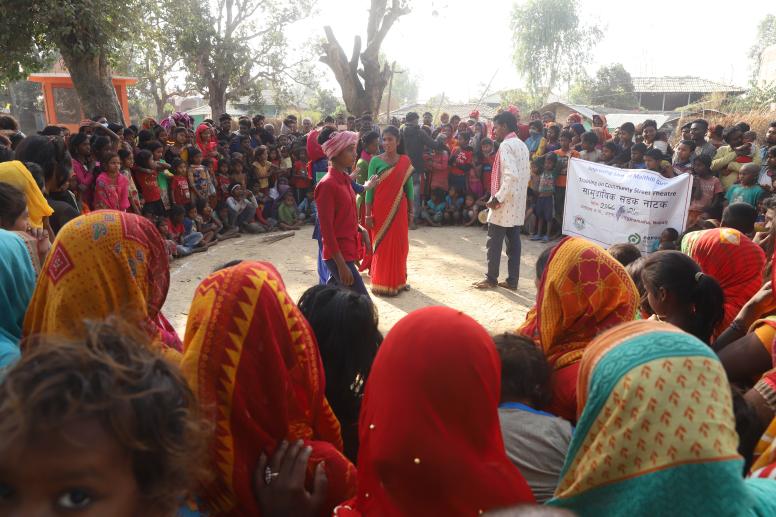
- Case study
- 29 octobre 2021
Entertainment-education to shift gender norms: Population Media Center
- Author: Faria A. Nasruddin
- Published by: ALIGN
Population Media Center (PMC), an American organisation founded in 1998, uses ‘entertainment-education and mass media to promote social and cultural change. It does so by addressing the interconnected issues of the full rights of women and girls, population, and the environment’ to achieve a sustainable planet with equal rights for all.
Theory of change
PMC uses the entertainment-education (sometime referred to as EE or ‘edutainment’) model inspired by the Sabido methodology. Miguel Sabido, a Mexican producer at Televisa, pioneered the entertainment-education model in the 1970s when he used telenovelas to promote literacy and family planning, among other pro-development social norms. At the centre of Sabido’s methodology is the social cognitive theory outlined by Albert Bandura, a Stanford psychologist, that people learn from role models and modelled behaviours.
Sabido argued that serial dramas, such as soap operas, heighten audience involvement, making them more likely to form bonds with the on-screen characters and, therefore, more likely to try to emulate their behaviour in reality. Aside from the audience’s greater amount of time invested in listening, entertainment media is more widespread and more deeply entrenched in the social fabric than, for example, documentary media content. As a result, serial dramas generate a social-emotional attachment between their audiences and characters through their presence in popular imagination. The Sabido methodology combines theoretical psychological elements with non-theoretical media formats (long-running serial drama; melodrama; dramatic, high-quality scriptwriting; and multimedia communicative campaigns) to create a character- and plot-centric behaviour change communication product.
Rajan Parajuli, the country director for PMC in Nepal, emphasises that behaviour change cannot be ‘forced’, but must be ‘motivated’. As such, entertainment is at the core of PMC’s dramas: ‘Entertainment has to play an important role’, he says. ‘People should be entertained first. No one wants to come to the radio to be taught; they have other platforms if they if they want to be taught’. Parajuli also noted that adolescents in particular have additional learning platforms available to them like school.


Methods
PMC recognises that broadcast media is for all, it's not only for children or only for adolescents or parents, with audiences listening to all kinds of television media and listening to all kinds of radio media. PMC brings real-life social issues into its media campaigns by using serial drama as a central component that is part of and builds into other direct communication campaigns. Drama is used as a major communication change approach, both for radio and television and for other possible outcomes. The emphasis has, however, been on radio around the world, as Parajuli explains: ‘We use radio as an impactful tool, because we have been working in mostly remote and low-income countries, where still radio is dominant mass media.’
Whilst broadcast media, specifically radio, forms of the core of PMC’s approach, digital media plays a useful supporting role. In Nepal, even in the most remote provinces, individuals have access to digital and social media, such as Facebook or Tik Tok. As a result, PMC has partnered with Viamo, a cellular and internet company, to broadcast radio dramas on digital platforms, where people can access them 24 hours a day, 7 days a week.
In addition, PMC integrates voice-response systems, SMS, Facebook, Clubhouse, and talk shows to generate audience participation and feedback. In Nepal, PMC partners with UNICEF to conduct content advisory groups and outreach into various communities. These on-the-grounds groups and individuals not only promote the drama but address individuals’ concerns in a timely manner.
PMC has developed two main radio dramas in Nepal: Mai Sari Sunakhari ('Orchid, Like Me') and Hilkor ('Ripples in the Water'). Mai Sari Sunakhari aired from April 2016 to April 2018 in Nepali, the official language of Nepal, while Hilkor aired from 2016 to 2017 in the Maithili language. Both dramas were broadcast on Radio Nepal, Kantipur FM, and 40 other stations through the Ujyaalo 90 Network. And both have addressed child marriage, domestic violence, education, family planning, gender equality, gender-based violence, maternal and child health, nutrition, and reproductive health.
Each drama that PMC develops is geared specifically to the regional or local context in which it will air to ensure that the dramas portray storylines that are relevant to the everyday reality of their audiences. To do so, PMC engages in two main research avenues: formative audience research and situational analysis. Both are used to gain country-, culture-, and locale-specific information about a social issue. It also gathers key information about the audience’s characteristics, needs, and preferences. These, in turn, determine the drama’s storylines and characters.


Additionally, PMC uses a multi-issue approach, bringing in three to four social issues into one drama, which has been shown to be cost effective and to reach large audiences. In addition, the multi-issue approach better mirrors reality, where various social issues are intertwined. For example, the main social issue in Mai Sari Sunakhari and Hilkor may have been child marriage, but other social issues like nutrition, gender-based violence, girls’ education, and family planning also arise.
‘Let's say if we are dealing the child marriage,’ says Parajuli. ‘We go to the audience to find all the driving factors and design the programme, and we propose a solution to them that is not widely available in their structural setting, and that is not guided by any concrete strategy or policy. Then, what happens is that no matter how the audience tries to change, they cannot find a solution.’
When tackling gender-based violence in Nepal, for example, the approach to ‘break the silence’ was not effective, as women who reported gender-based violence to the police found that the police would mediate on behalf of the perpetrator. As Parajuli explains: ‘If the structure and mechanism does not support that, then asking for their behaviour change is always counterproductive’.
Formative audience research and situation analysis revealed a key discrepancy between provinces in Nepal. Initially, PMC intended to produce one single, national-drama that would cover the topic of child marriage, but realized that Province Two of the country differed significantly from the rest of Nepal. Nationally, Human Rights Watch reports that a growing number of children across the country engage in ‘love marriages’ to escape difficult or abusive situations; Girls Not Brides reported in 2014 that these ‘love marriages’ accounted for 1 in 4 of all child marriages in Nepal. In Province Two, however, love marriage was rare, and arranged marriages were the dominant factor for child marriage. And so, Hilkor was created specifically for Province Two and features a father, rather than an adolescent girl, as the central character.
Based in Sabido’s methodology, PMC designs entertainment-education dramas that focus on developing three character-models: positive, negative, and transition. The positive character is an ideal hero and holds positive values in relation to the issues tackled in the drama, while the negative character holds negative values. Both of these characters attempt to influence the transition character, typically the main character of the series, and draw them into their own value systems. The mirror-format is not new to media, but Parajuli argues that these ideal positive and negative characters are not good role models, as people cannot relate to them. The transition character, or ‘doubty’ character, is the ‘secret sauce’ of PMC’s approach. This character holds a neither positive nor negative value system, and is, therefore, the most relatable to the audience.
‘For example, a father wants his daughter who have a good life, Parajuli explains. ‘He wants to be a responsible father, but what he thinks is marrying his daughter early will help her to have a nice life. It's the journey of the doubty character that we prepare in the drama. We do in such a way that our audience will start liking that transitional character, and that transitional character will ultimately be the role model, who will inspire or motivate people to try something in their real life that they haven't been able to try because of fear, because of stigma, because of the norms that they have in the community’.
Because PMC’s behaviour change radio dramas are, first and foremost, entertainment, there are extensive promotional campaigns that draw on celebrities and well-known national personalities. For Mai Sari Sunakhari, for example, PMC hired Rajesh Hamal, a Nepali film actor, and former president Ram Baran Yadav to promote the drama. Ram Baran Yadav was chosen because of his life story; he was married at the age of 14 and so was his sister. While Ram Baran Yadav went on to become a doctor and hold the highest political office, his sister never returned to school. To PMC, their story demonstrates the disproportionate impact of child marriage on girls. That being said, PMC never promotes their dramas as being solely about child marriage, family planning, gender empowerment or any other specific development issue.


Evidence of change
PMC conducts evaluation reports once the radio dramas end to gauge the impact on social norm change. For Mai Sari Sunakhari, 11% of survey participants said that they were motivated by the drama to get family planning/reproductive health services, with men (17%) motivated at a notably higher level than women (10%). Participants who listened to Mai Sari Sunakhari were more likely to ‘disapprove/strongly disapprove’ of child marriage (80%) than those in the survey who said they did not listen to Mai Sari Sunakhari (75%). And, when asked, ‘Have you taken any action to discourage child marriage?’ those who had listened to Mai Sari Sunakhari were more likely (24%) than non-listeners (11%) to say yes.
As for Hilkor, 18% of survey participants said they were motivated by the drama to get family planning/reproductive health services: again, men (22%) were more likely than women (17%) to seek services. Participants who listened to Hilkor were more likely to 'disapprove/strongly disapprove' of child marriage (94%) than those in the survey who said they did not listen (90%); however, this was not statistically significant. And, when asked, ‘Have you taken any action to discourage child marriage?’ those who had listened to Hilkor were more likely (59%) than non-listeners (39%) to respond yes.
An end-line survey conducted at the national level found that Mai Sari Sunakhari listeners were 7.1 times more likely to believe they should be able to initiate a divorce, and 5.1 times more likely to believe they should be able to remarry, compared to non-listeners. Listeners were also 3 times more likely to believe that people in the community should advocate to end child marriage than non-listeners, and 2.1 more times likely to have taken direct action to discourage child marriage than non-listeners. Hilkor listeners were 2.9 times more likely than non-listeners to discuss child marriage and related issues with others.
In focus group discussions, PMC found that those who had listened to Mai Sari Sunakhari ‘were able to recall key educational messages that were addressed in the drama and link them to the main characters for each storyline’, particularly those related to child marriage, education, and GBV. Participants learned from the drama that their beliefs about child marriage were wrong: they identified with the story of Junimaya (the main character) and linked child marriage with stopping education as a negative consequence. In addition, many women participants saw the characters of Chandrakala and Upasana as ‘strong’, linking their independence with empowerment.
Notably, ‘many participants across all FGDs spontaneously expressed that they had learned that even if they did marry early, they could still go back to school to make a better life for themselves. The majority of the participants’ sketches depicted Junimaya continuing her education even after getting married at a young age.’


Looking to the future
PMC is now planning another serial drama of 104 episodes over one year, also on child marriage and parent education. While child marriage has continued throughout Nepal since the initial campaigns from 2016 to 2018, the picture is now increasingly complicated by a growing trend for elopement. Arranged marriages still comprise the majority of child marriages, but elopement has become a ‘trending’ issue highly intertwined with arranged marriage. Furthermore, formative audience research has shown that adolescents are already well aware of the consequences of child marriage.
As a result, in the new drama, the transition character will be able to ‘get away with everything’ and is not married off. This drama, unlike the previous two which showcased the consequences of child marriage, will offer examples, tips, and tools that, as Parajuli explains, ‘every adolescent can use to get away from marriage, to convince their parents to manage the dream, how to manage the love that you feel, and avoid the trap that puts you in trouble’.
- Tags:
- Broadcast media, Media
- Countries / Regions:
- South Asia
More case studies
Interview
15 décembre 2021

Interview
6 décembre 2021

Case study
1 novembre 2021

Case study
1 novembre 2021

Case study
29 octobre 2021

Case study
29 octobre 2021

Case study
29 octobre 2021

